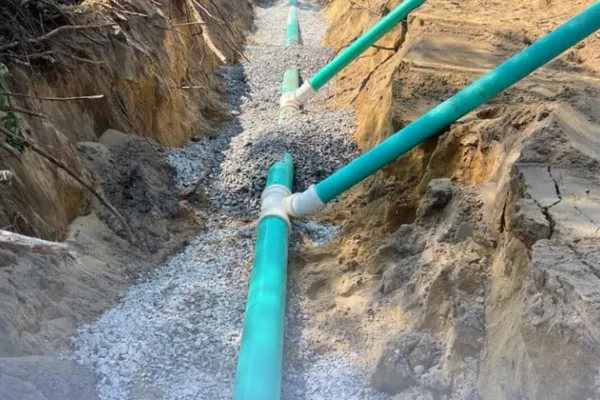
How to Repair Stormwater Drainage in Older Parking Lots
Aging parking lots across Florida often show signs of wear and tear, but one of the most overlooked problems lies beneath the surface: stormwater drainage. Over time, stormwater systems break down, leading to flooding, pavement damage, and environmental issues. For property owners and facility managers, identifying and addressing these problems early can prevent costly repairs down the road.
This guide will walk you through the most common stormwater repairs Florida parking lots may need, what signs to look for, and how to keep your drainage systems working properly for the long term.
Causes of Stormwater Failures
Most parking lot drainage systems are built to last 20 to 30 years, but over time, wear and tear, poor maintenance, and environmental conditions can lead to premature failure. These are the most common causes of drainage issues in older parking lots:
Clogged or Collapsed Pipes
As sediment, debris, and leaves accumulate in underground stormwater pipes, flow is restricted. Eventually, this buildup can block water altogether. In some cases, pipes collapse due to soil movement or corrosion, especially if they were made of outdated materials like corrugated metal.
Inlet Failures
Stormwater inlets, or catch basins, collect water and direct it into the drainage system. When these inlets become damaged, sink, or crack due to soil settlement or improper compaction, water no longer drains properly. Inlet failures are a common problem in older lots with aging subgrades.
Poor Surface Grading
Asphalt and concrete surfaces settle and shift over time. In some cases, an improper slope during the original construction leads to low spots where water pools. Without the right surface grade, even the best stormwater system can’t do its job.
Vegetation Growth and Root Intrusion
Tree roots often find their way into joints in underground pipes, especially in areas that haven’t had regular stormwater maintenance. These roots can cause blockages and even break pipes apart.
Surface Cracking and Pavement Damage
Once water begins to pool or leak underneath the pavement, cracks form and expand. This leads to potholes, base layer erosion, and eventually structural failure of the parking lot.
Signs You Need Repairs
Recognizing the signs of stormwater issues can help you address problems early. Here are the most common indicators that stormwater repairs for Florida properties may require:
Standing water after light or moderate rain
Sinkholes or depressions around inlets or storm drains
Pavement cracking in consistent patterns near drainage structures
Foul odors coming from inlets or manholes, which may indicate stagnant water or blockages
Vegetation overgrowth in areas that should be dry
Visible pipe fragments or debris near catch basins
If any of these signs are present, it’s a good idea to schedule an inspection with a drainage professional who can assess the system and recommend solutions.
The Repair Process
Fixing stormwater problems in older parking lots involves more than patching potholes. A thorough repair process looks at the surface, sub-surface, and entire stormwater system. Here's a step-by-step overview of how stormwater repairs in Florida typically unfold.
1. Inspection and Mapping
First, a drainage contractor will inspect your parking lot. This may involve visual checks, water flow testing, or using a pipe inspection camera to look underground. Older systems may lack up-to-date as-built drawings, so mapping the layout is important.
2. Identifying the Failure Points
Once the system is inspected, the team identifies specific failure points. This might include broken pipes, disconnected inlets, clogged basins, or areas of improper slope. Inlet failures are especially common in commercial lots and should be checked for structural stability.
3. Excavation and Replacement
Depending on the severity of the issue, excavation may be required. For example, if a catch basin has collapsed, the concrete structure will be removed and replaced. Damaged sections of pipe are either replaced or relined using trenchless technology when feasible.
4. Grading and Surface Repair
Once the drainage components are fixed, attention turns to the parking lot surface. Low spots are regraded to ensure proper slope. Cracked or damaged asphalt or concrete is replaced to restore a smooth, durable surface.
5. Testing and Final Inspection
Before the job is complete, the contractor performs a flow test to ensure water is moving as intended. Stormwater must flow away from the lot and not pool in undesired areas.
Long-Term Maintenance Tips
Repairing a drainage system is a critical first step, but long-term success depends on regular stormwater maintenance. Here are simple ways to extend the life of your stormwater infrastructure:
Schedule Annual Inspections
Even if there are no visible problems, having a professional inspect the drainage system once per year can catch small issues before they become major repairs. Fall is a great time to do this, before winter storms or hurricane season.
Clean Inlets and Basins
Catch basins and inlets should be cleared of debris, sediment, and leaves regularly. This can often be done by hand or using a vacuum truck for larger systems. Clogged inlets are the number one cause of surface flooding in aging lots.
Remove Tree Roots
If your parking lot is surrounded by mature trees, consider having a root barrier installed or using hydro-jetting to remove intruding roots. Left unchecked, roots can destroy even newer stormwater systems.
Reseal Pavement
Asphalt should be resealed every few years to prevent water intrusion. Cracks and potholes should be filled immediately to avoid water damage to the subbase.
Monitor Drainage Performance
After heavy rains, take note of how quickly water drains. If you see pooling, it may be time for a follow-up inspection. Minor adjustments like regrading or inlet cleaning can often solve the problem without needing full-scale repairs.
Why It Matters in Florida
Florida's weather patterns, flat terrain, and sandy soils make stormwater management a critical part of any paved surface. Without proper parking lot drainage, even a light afternoon thunderstorm can cause major problems.
Frequent rain, coupled with long dry spells, also increases the risk of inlet failures and pavement erosion. Poor drainage doesn’t just damage property. It increases liability risks, creates unsafe walking conditions, and can even violate environmental regulations.
According to the Florida Department of Environmental Protection (FDEP), all stormwater systems must meet certain standards for flow and water quality. Failing to maintain them can result in fines or compliance violations, especially for commercial property owners.
The EPA’s National Pollutant Discharge Elimination System (NPDES) also holds property managers accountable for stormwater runoff that causes environmental harm. Routine maintenance helps avoid these issues and keeps properties within compliance.
Plan Ahead and Protect Your Investment
Stormwater systems in aging parking lots may be out of sight, but they should never be out of mind. From collapsed pipes to clogged inlets, hidden problems can lead to costly damage and frustrated tenants or customers. Addressing drainage issues early, with a well-planned repair and maintenance strategy, protects your property for the long haul.



